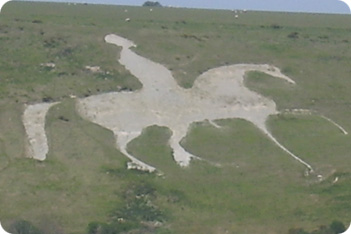
White Horse
Hillside Chalk Art
From: Equestrian and Horse
See Also: Equine Art

White Horse - Hillside Chalk Art
When an image of a white horses carved into the hillside it is known as Leucippotomy. These images can often be seen over quite a fair distance with some carvings actually being better viewed from the air, which adds mystery as to their actual reason for being put there in the first place.
There are many white horse images in England and each one is very unique in design. Some of the horses are carved in motion while others are standing tall, there are some figures that are sleek in design and others that have the horses with a fuller figure.
The reason they are known as white horses is due to them often being carved where chalk is naturally underneath the ground so that when an image is cut into the ground surface a chalk image is produced that can be clearly seen from afar.
Although the exact purpose of why many of these early white horses were produced is not truly known, they are certainly wonderful works of art that can be enjoyed by everyone.
Cherhill White Horse - The Cherhill White Horse is also known as the Oldbury White Horse and was produced in 1780. It lies on a steep slope of Cherhill Down in Wiltshire, England.
More About The Cherhill White Horse
Folkestone white Horse - One of the latest hill figures to be made is the Folkestone White Horse which was produced in 2003. The horse is on Cheriton Hill which is in Folkestone, Kent in the South East of England.
More About The Folkestone White Horse
Uffington White Horse - One of Britain's oldest and most famous hill figures is the Uffington White Horse which can be seen on White Horse Hill on the Berkshire Downs.
More About The Uffington White Horse
Westbury White Horse - This is also known as the Bratton White Horse and shows the figure of a white horse standing still on Westbury Hill on Salisbury Plain, England.
More About The Westbury White Horse